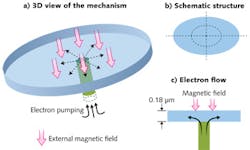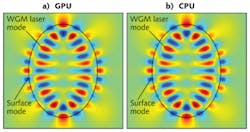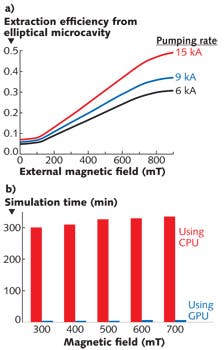SOFTWARE: OPTICAL DESIGN: Multiphysics model speeds nanophotonic devices simulation
IFTIKHAR AHMED and ENG HUAT KHOO
High-speed data transfer and device miniaturization are growing interests in the field of photonics, pushing researchers both in academia and industry towards new opportunities and frontiers in the field. To meet these challenges, new approaches to simulate photonics devices are needed.
Our team at A*STAR and the University of Tabuk have recently developed a three-dimensional (3D) solid-state simulation approach that uses several mathematical principles and physics effects (multiphysics approach) to simulate devices such as novel lasers and other components from macro to atomic scales.1,2 We have incorporated many features in the approach to simulate a wide range of applications. One of the features of our approach models the electron transition mechanism in energy levels under the influence of an external magnetic field.
Simulating altered states
The presence of an external magnetic field alters the orbital properties of optoelectronic materials. When a magnetic field is applied perpendicular to the motion of electrons in metallic or semiconductor structures, a Lorentz force is experienced that gives rise to different phenomena. We applied an external magnetic field to an electron-pumped semiconductor microcavity to modify its charge distribution, which in turn changes its lightwave distribution (see Fig. 1).
The confined whispering gallery modes (WGMs) in the microcavity contribute to the amplification of light energy to form coherent laser modes. Light is then extracted using an evanescent coupling mechanism and the external magnetic field enhances the extraction efficiency of the microcavity laser. Higher extraction efficiency is always needed due to the presence of high coupling and radiation losses in photonic integrated circuits (PICs).
The Lorentz force from the external magnetic field pushes electrons towards the edge of the elliptical microcavity. Energy levels change with the application of an external magnetic field and are labeled as Landau energy levels. In our modeling and simulation algorithm, there are different multi-physics features such as the Pauli exclusion principle, state filling effect (absorption/loss of light energy for an electron to fill up/degenerate down to different energy states), dynamic Fermi-Dirac thermalization effect, and the external magnetic field. By varying the strength of the external magnetic field and pumping current density, our multi-physics approach can control the movement of the electron in the device. Hence, we can change the intensity of light in the device and can obtain different light extraction efficiencies.
Lower external magnetic field strengths and pumping rates cause lower extraction efficiency due to lesser electron accumulation at the edges of the cavity, while higher field intensities and pumping rates enable higher light extraction due to larger accumulation of electrons at the edges. For example, at 900 mT and 18 kA/cm2, the extraction efficiency is improved significantly to 34%.2 This considerable increment shows the potential of transferring more light energy to PICs without the use of optical amplifiers or secondary sources.
By using this same principle, another interesting application of a semiconductor microcavity is simulated that generates both laser and surface modes. Compared to the previous example, the magnetic field is applied at the center encompassing approximately 40% of the total elliptical area.
After a certain period of electrical pumping and exposure to the external magnetic field, the injected electrons accumulate on the edge of the microcavity to form plasma. At the same time, the microcavity WGM allows the generation of coherent laser light, which interacts with the electron plasma to form surface plasmon polaritons (SPPs). In this way, two different modes are observed: one is a laser mode and the second one is a surface mode. This excitation of SPPs by applying an external magnetic field improves the light extraction efficiency by 20%.
The SPPs can be controlled by the external magnetic field to tune the extraction efficiency for different applications such as magnetic field hazard detection, quantum logic gates, and nanocontrol systems. This unique application that is simulated with our (in-house developed) model creates two light sources using a single device (ideal for device miniaturization requirements): a surface plasmonic source and a laser source.
Algorithm implementation
Using a modest graphics processing unit (GPU) card (Nvidia Tesla C2050 card with 14 multiprocessors of 32 processing cores each, or 448 total processing cores) and a workstation with specification of Core 2 Quad 3.2 GHz and 4 GB RAM, we implement our numerical algorithm for active plasmonic applications. This 3D dynamic thermal electron quantum medium finite-difference time-domain (DTEQM-FDTD) algorithm is implemented on a GPU using the CUDA (see http://www.nvidia.com/object/cuda_home_new.html) parallel computing platform and programming model. To our knowledge, this is the first demonstration of GPU simulation for active nanophotonic applications using an external magnetic field.In our example, an elliptical semiconductor microcavity is simulated, and the simulation time is reduced from around 300 min to less than 1 min (see Fig. 3). This huge reduction in simulation time for active nanophotonic devices is a strong mandate for the development of more sophisticated modeling options through implementation of GPU-based computing. This may help to reduce the design and fabrication time for a device and improve a company's bottom line in today's competitive environment.
REFERENCES
1. E. H. Khoo et al., IEEE J. Quantum Electron., 46, 1, 128–136 (2010).
2. E. H. Khoo, I. Ahmed, and E. P. Li, Appl. Phys. Lett., 95, 12, 121104 (2009).
Iftikhar Ahmed is associate professor at the University of Tabuk, King Faisal Road, Educational Estate, Tabuk City, Tabuk, Saudi Arabia; e-mail: [email protected]; www.ut.edu.sa. Eng Huat Khoo is a research scientist at the A*STAR Institute of High Performance Computing, 1 Fusionopolis Way, #16-16 Connexis North Tower, Singapore 138632; e-mail: [email protected]; www.a-star.edu.sg.


